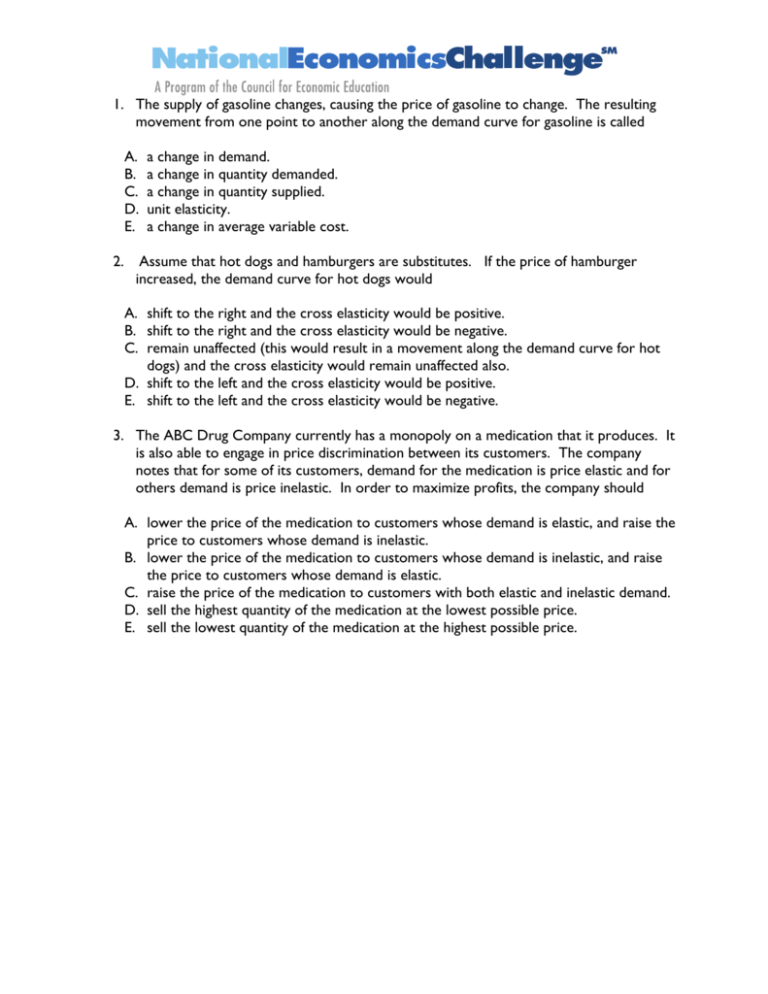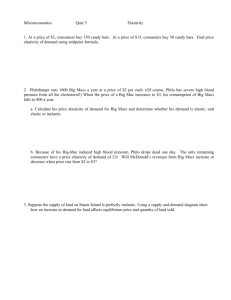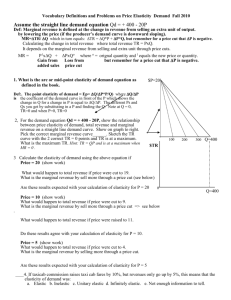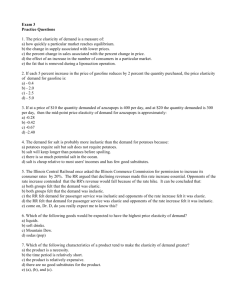1. The supply of gasoline changes, causing the price of gasoline to
advertisement

1. The supply of gasoline changes, causing the price of gasoline to change. The resulting movement from one point to another along the demand curve for gasoline is called A. B. C. D. E. 2. a change in demand. a change in quantity demanded. a change in quantity supplied. unit elasticity. a change in average variable cost. Assume that hot dogs and hamburgers are substitutes. If the price of hamburger increased, the demand curve for hot dogs would A. shift to the right and the cross elasticity would be positive. B. shift to the right and the cross elasticity would be negative. C. remain unaffected (this would result in a movement along the demand curve for hot dogs) and the cross elasticity would remain unaffected also. D. shift to the left and the cross elasticity would be positive. E. shift to the left and the cross elasticity would be negative. 3. The ABC Drug Company currently has a monopoly on a medication that it produces. It is also able to engage in price discrimination between its customers. The company notes that for some of its customers, demand for the medication is price elastic and for others demand is price inelastic. In order to maximize profits, the company should A. lower the price of the medication to customers whose demand is elastic, and raise the price to customers whose demand is inelastic. B. lower the price of the medication to customers whose demand is inelastic, and raise the price to customers whose demand is elastic. C. raise the price of the medication to customers with both elastic and inelastic demand. D. sell the highest quantity of the medication at the lowest possible price. E. sell the lowest quantity of the medication at the highest possible price. Directions: Use the graph below, which shows the supply and demand for cheese, to answer questions 4 and 5. Assume that the price per pound of cheese is measured on the vertical axis and the quantity of cheese in pounds is measured on the horizontal axis. 4. If the government made it illegal for the price of cheese to fall below $8 per pound, A. this would be an example of a price ceiling and would result in a surplus of 20 pounds of cheese. B. this would be an example of a price ceiling and would result in a shortage of 40 pounds of cheese. C. this would be an example of a price floor and would result in a surplus of 40 pounds of cheese. D. this would be an example of a price floor and would result in a shortage of 40 pounds of cheese. E. this would be an example of a price floor and would result in a shortage of 20 pounds of cheese. 5. Assume that the market clears at the equilibrium price and quantity. According to the graph, what is the amount of producer and consumer surplus combined? A. B. C. D. E. $480 $400 $240 $160 $80 6. In microeconomics, the basic characteristic of the long run is that A. B. C. D. E. the firm cannot change its plant and equipment. the firm cannot hire and fire workers. goods and services produced must last for more than five years. all resources and all costs are variable. the firm cannot shut down its operations while remaining in business. Directions: Answer questions 7, 8, and 9 using the graph below, which shows demand, marginal cost, average total cost, and average variable cost curves for a profit-maximizing firm in perfect competition. 7. If the competitive firm shown faced a market price of P3, it would choose to produce A. B. C. D. E. output quantity Q1 and it would be making economic profits. output quantity Q2 and it would be breaking even. output Quantity Q3 and it would be making economic losses. output Quantity Q4 and it would be making economic profits. output Quantity Q6 and it would be making economic losses. 8. In the short run, if the competitive firm shown faced a market price of P1, A. B. C. D. E. the firm would be breaking even. the firm would choose to shut down. the firm would raise its price to P3 in order to sell more output. the firm would lower its price below P1 in order to sell more output. the firm would choose to produce output quantity Q2. 9. If competitive firms faced a market price of P2 and produced the profit maximizing quantity of output, in the long run they would A. be earning economic profits and new firms would enter the industry. B. be earning zero economic profits and firms would leave the industry. C. be earning zero economic profits and firms would neither enter nor leave the industry. D. be making economic losses and existing firms would stay in the industry. E. be making economic losses and firms would leave the industry. Directions: Questions 10 and 11 should be answered using the graph below, which shows demand, marginal revenue, marginal cost, and average total cost curves for a monopolist. 10. To maximize profits, this firm would choose to produce quantity ________ and would charge price __________. A. B. C. D. E. A, F A, J B, G D, I E, H 11. Assuming that the firm is producing the profit maximizing quantity and charging the profit maximizing price, it is A. B. C. D. E. breaking even suffering economic losses produce at the same price and quantity that would occur in perfect competition receiving a government subsidy making economic profits 12. Assume that external benefits exist in the consumption of vaccinations. If these positive externalities are not taken into account or corrected, then, when compared with the socially optimal solution, A. B. C. D. E. too few vaccines will be produced by the market, and the government could help to correct the problem with taxes that would raise the price of vaccines to vaccine consumers. too many vaccines will be produced by the market, and the government could help to correct the problem with subsidies that would decrease the quantity of vaccines consumed. too few vaccines will be produced by the market, and the government could help to correct the problem with subsidies that would increase the quantity of vaccines consumed. too many vaccines will be produced by the market, and the government could help to correct the problem with taxes that would raise the price of vaccines to vaccine consumers. the socially optimal amount will be produced by the market, so the government should not impose taxes or subsides. 13. State University makes this announcement: "We are going to raise tuition fees because we need to increase tuition revenues to the university to make up for losses in government funding." From this statement we know that State University is assuming that A. demand for their services is elastic. B. demand for their services is unit elastic. C. demand for their services is nonexistent. D. demand for their services is perfectly elastic. E. demand for their services is inelastic. 14. In the short run, the supply curve of a firm in pure competition A. B. C. D. E. is the marginal cost curve above the market price. is the marginal cost curve above minimum average variable cost. is the average total cost curve above marginal cost. is the average variable cost curve above marginal cost. consists of the points where the demand curve equals average total cost. 15. Suppose that Kim and Robert are the only two members of society. Kim is willing to pay $9 for the third unit of a public good. Robert is willing to pay $8 for the third unit of the same public good. The government's marginal cost of producing the third unit of the public good is $15. If the government's goal is to produce the optimal quantity of the public good, A. B. C. D. E. the third unit of the public good should be produced. zero units of the public good should be produced. the third unit of the public good should not be produced. one unit of the public good should be produced, but no more. the public good should be produced by the private sector. ANSWER KEY 1. B 2. A 3. A 4. C 5. D 6. D 7. D 8. E 9. C 10. B 11. E 12. C 13. E 14. B 15. A









